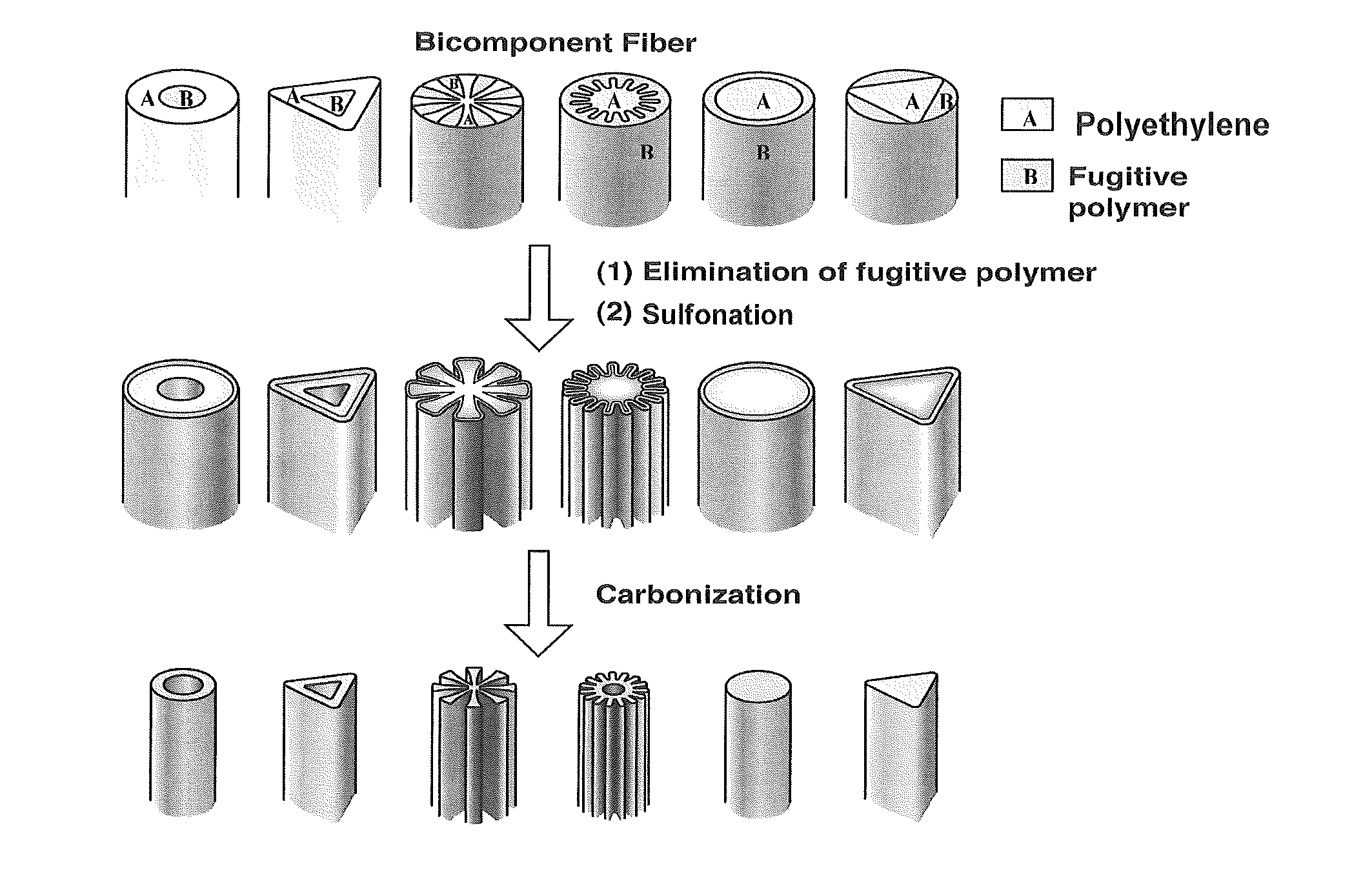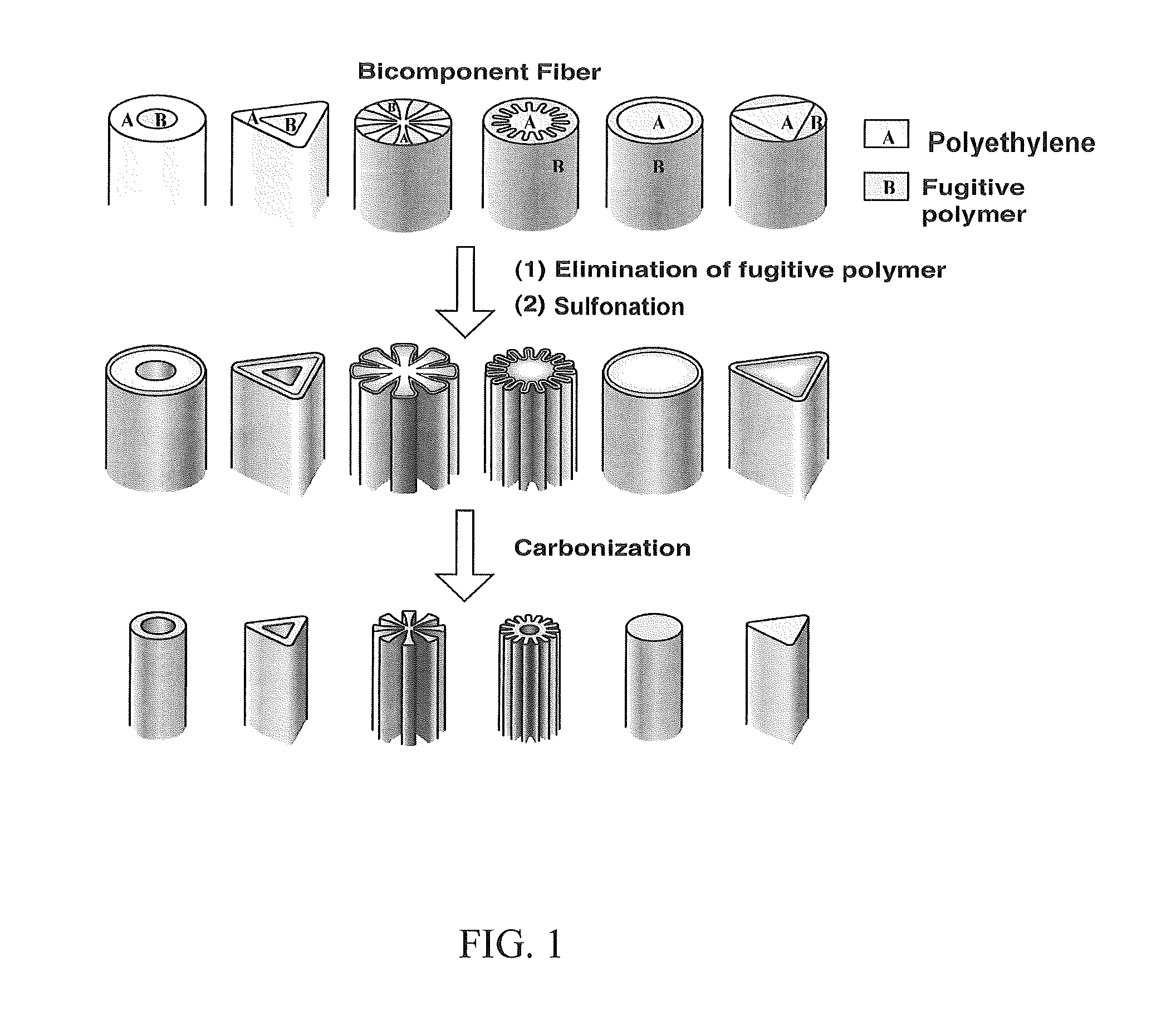Method for production of carbon nanofiber mat or carbon paper
- Summary
- Abstract
- Description
- Claims
- Application Information
AI Technical Summary
Benefits of technology
Problems solved by technology
Method used
Image
Examples
example 1
Production of a Non-Woven Mat Made of Carbon Fibers from LLDPE Fiber Precursor by Hydrogen Bonding Self-Assembly of Sulfonated Fibers
Preparation of LLDPE Fibers
[0081]Linear low-density polyethylene (LLDPE) was spun into fibers with varied diameters ranging from 0.25 to 20 μm by conventional melt-spinning using both single and bi-component extrusion processes. For bi-component spinning, polylactic acid (PLA) resin was used as the second (fugitive) component dissolved in a continuous operation using a tetrahydrofuran solvent bath at 50° C. Depending on the degree of molecular orientation, LLDPE fibers had a crystallinity of 50-60% and a tensile strength of 100-170 MPa when tested at 25° C. and at 3 mm / min strain rate for 25.4 mm-long single filament specimens on a MTS tensile tester. Bicomponent (i.e., “islands in a sea”) spun strands of LLDPE islands were mostly undrawn filaments which were subsequently stretched at 50° C. to reduce the diameter. The final filaments of LLDPE of 0.2, ...
example 2
Production of a Non-Woven Mat Made of Carbon Fibers from Polyethylene (PE) Fiber Precursor by Mechanical Bonding of PE Fibers Followed by Sulfonation
[0085]Polyethylene filaments of 20 μm diameter and 1 inch length were mixed randomly and pressed or stamped at 130° C. using a compression mold. For example, localized stamping on a mat by passing the thick filament layers through a grooved hot roller was simulated in the lab. In this way, a non-woven bonded precursor mat was produced. Sulfonation of the PE precursor mat was conducted at 70° C. using oleum. The sulfonated mat was washed and dried at 100° C., and then carbonized at 1000° C. Scanning electron microscope (SEM) images of the resulting carbonized mats processed under identical conditions are displayed in FIGS. 6A-6B. FIG. 6A shows bonded filaments in a very thin mat, whereas FIG. 6B shows bonded carbon mat containing a high density of filaments. The density of filaments can be measured as bulk density or as mass per unit vol...
example 3
Production of a Non-Woven Mat Made of Carbon Fibers by Use of a Plasticizer and Hot Stamping
[0087]A sulfonated tow of LLDPE fibers that was sulfonated at 97° C. for 10 hours appeared to be in plasticized form (plasticized with conc. sulfuric acid). The fibers exhibited 20% or more ultimate elongation, i.e., significant stretchability. The sulfonated tow was also plasticized with vegetable oil-based spin finish, water, or glycerol solution prior to carbonization. A SEM image of a fully sulfonated plasticized tow is shown in FIG. 7. As shown by the SEM image, the surfaces of the fibers are deformed by virtue of the substantial ductility of the plasticized fibers. The tow was hot pressed at 100° C. to make a hot pressed mat of randomly oriented filaments. The mat was subsequently carbonized at 1000° C.
[0088]A carbon fiber mat was also produced from an oleum-treated intermingled bundle of 20-micron diameter gear-shaped LLDPE precursor. The tow was sulfonated at 80° C. for 1 hour. The dr...
PUM
| Property | Measurement | Unit |
|---|---|---|
| Diameter | aaaaa | aaaaa |
| Diameter | aaaaa | aaaaa |
| Diameter | aaaaa | aaaaa |
Abstract
Description
Claims
Application Information
 Login to View More
Login to View More - R&D
- Intellectual Property
- Life Sciences
- Materials
- Tech Scout
- Unparalleled Data Quality
- Higher Quality Content
- 60% Fewer Hallucinations
Browse by: Latest US Patents, China's latest patents, Technical Efficacy Thesaurus, Application Domain, Technology Topic, Popular Technical Reports.
© 2025 PatSnap. All rights reserved.Legal|Privacy policy|Modern Slavery Act Transparency Statement|Sitemap|About US| Contact US: help@patsnap.com



